Art provides an outlet for expression and allows artists to curate new perspectives for viewers. The origin of art is untraceable, a veritable archeological and anthropological puzzle. Numerous art movements have dominated history, each bearing its own distinctive style and characteristics that reflect the political and social forces of their time. Each time period is championed by a few key influential artists that have changed the way art is defined.Their work, unlike any other, appeals to a uniquely human idea of “art”.
Controversial art has a habit of sticking with its audiences. Creators of controversial art aim to provoke their viewers into emotional response. Irrespective of the time frame, there are always some artists who boldly reject conventional forms of art and depict topics that are considered taboo. The following is a list of five Western works of art that created intense controversy after their initial publication. Surprisingly, today most of these are considered some of the greatest works of art in Western history.
The Last Judgement - Michelangelo, c. 1536-1541
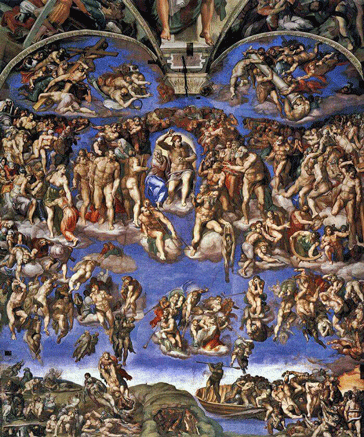
This spectacular painting by Renaissance painter Michelangelo covers the entire altar wall of the Sistine Chapel in the Vatican City. The painting was commissioned by Pope Clement VII, illustrating the Second Coming of Christ and the final judgement by God on all of humanity. In The Last Judgement, Christ is surrounded by his saints as he judges the fate of the dead. There are over 300 characters included in the painting, with nearly all the males and angels originally painted as nude figures. The lower half of the image portrays the saved individuals ascending to heaven while the damned are dragged to hell. Michelangelo's work created a distinct contrast between the heavenly world above and the disturbing acts taking place in the earthly zone below. It gives an appearance of anxiety and enthusiasm, indicating tension and contrast between in the figures. The painting fueled controversy at its completion. It sparked a major feud between the Catholic Church and supporters of Michelangelo's work. Many Catholics felt that The Last Judgement was inappropriate for a place as sacred as the chapel, and were disgusted that Michelangelo displayed nude figures in such a holy place, stating that the art was better suited for public baths and taverns. After Michelangelo's death the controversy over nudity continued and artist Daniele da Volterra was hired to cover up the genitalia by adding fig leaves and loincloths.
Guernica - Pablo Picasso, 1937
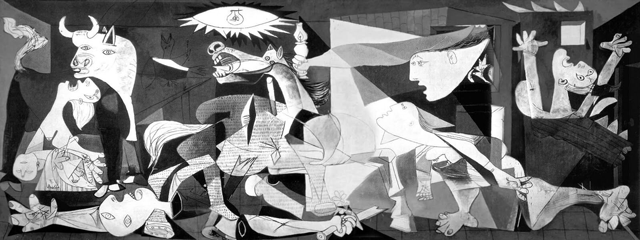
The 1937 oil painting Guernica by Spanish artist Pablo Picasso is one of the best known anti-war paintings in Western history. It has been acclaimed by art critics as one of Picasso’s best works. The artwork depicts the suffering of humans and animals created by violence and disorder. It includes a gored horse, a bull, screaming women, mutilation and fire. Picasso painted Guernica, a town in northern Spain, in reaction to the bombing by Nazi Germany and Fascist Italy. The painting brought worldwide attention to the Spanish Civil War and its atrocities. At the time, it was adapted into a piece of war propaganda, used to oppose Fascism and increase consciousness on the slaughter of Spanish civilians. The painting created a contrast between art and politics, while at the same time making an effective political statement through the rejection of traditional techniques. After its completion, Guernica was displayed at the 1937 Paris International Exhibition in Spain and later went on to be exhibited at other venues around the world.
Self - Marc Quinn, 1991
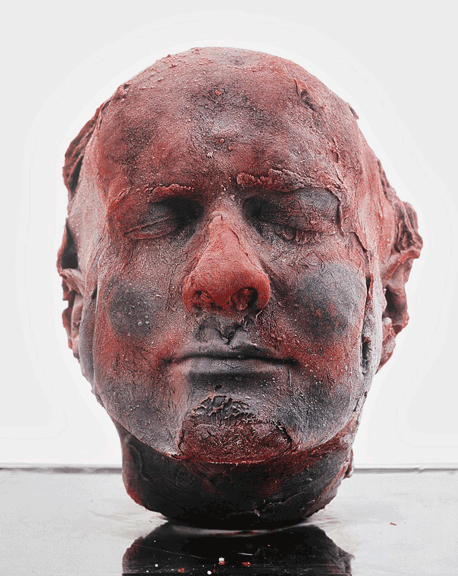
Self is a self-portrait of Marc Quinn. It was created using only the artist’s body as material. The cast of Quinn’s head came from frozen silicone and ten pints of his own blood. The sculpture carries a symbolic significance to Quinn’s previous alcoholism. Quinn's creation of a sculpture that requires electricity to preserve its frozen look illustrates the notion of dependency and the need to be plugged in or connected in order to survive. Every five years, Quinn pours five litres of his own blood into the cast to keep it looking new. The sculpture portrays the accumulated index of passing time and displays the ageing and evolving identity of the artist. Self has been received as a very gruesome and chilling piece of art. It is both contentious and unusual in its use of materials, providing a modern dark outlook on art that was previously unknown.
Myra - Marcus Harvey, 1995
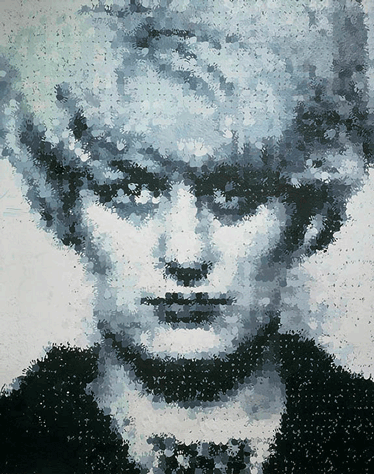
Myra is a 1995 painting created by artist Marcus Harvey based on Myra Hindley’s mugshot in 1965. Hindley was a serial killer in the 1960’s who murdered five children between the ages of 10 and 17. At first sight, the painting looks like a magnified version of a black and white photograph printed in a newspaper. However, the painting was actually made using photographs of an infant’s hand to create a mosaic of black, grey and white handprints. In the decades following Hindley's arrest, the mugshot was featured in British newspapers, making it familiar worldwide. Harvey attempted to represent the influence of photography over years of obsessive media replication. He believed that Myra was undeserving of the title as one of the most vile and notorious murders in British criminal history. The painting juxtaposes the small handprints of an innocent child and the vicious shameless world of adults on a massive canvas. Myra was included in the Sensation exhibition of Young British Artists at the Royal Academy of Art in London 1997, and was one of the most important paintings at the show. However, it led to major controversy between the press and the public. On the opening day of the exhibition, two artists defaced the artwork with ink and eggs. The painting was deemed controversial for its insensitivity towards the emotional pain and trauma that families of the children’s victims had experienced.
The Holy Virgin Mary - Chris Ofili, 1996
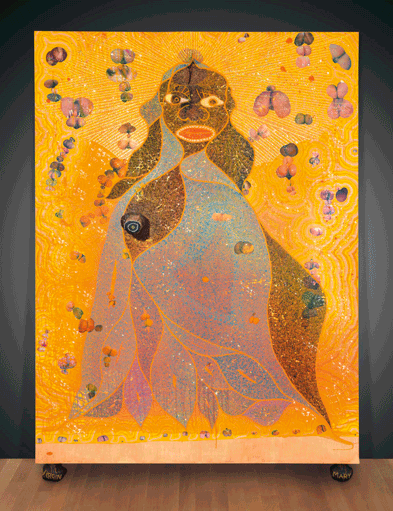
The Sensation exhibition of Young British Artists at the Royal Academy of Art also featured another shocking work of art. The Holy Virgin Mary by Chris Ofili depicted a black Mary, wearing a blue robe, surrounded by female genitalia cut out from pornography magazines and a bare breast made from elephant dung. The painting is displayed against the exhibition wall, supported by two other lumps of elephant dung. It is decorated with coloured pins that spell out “Virgin Mary”. The piece highlighted racial stereotypes inherent in Western representations of biblical figures. Not only did Ofili portray Mary as a black character, but he also played into the stereotype of oversexualizing black women specifically. His art provided a potent new conception of the Virgin Mary, compelling audiences to see her as more than just a white biblical character. The exhibition of the painting caused major outrage amongst critics and religious leaders. New York mayor Rudy Giuliani called the art sick and anti-Catholic, threatening to cut funding from the museum if it was not immediately removed. Protesters tried to destroy it with white paint and horse manure. Today, The Holy Virgin Mary has gained recognition in the arc of art history and is currently in the permanent collection of the Museum of Modern Art.
Together, these artworks demonstrate the transforming and evolving history of art in Western tradition. They prove that innovative art has to challenge boundaries and break limits in order to leave a mark. If these artists had not been brave enough to impose new perspectives on the viewer, art would seldom move forward and fail to bring new wonder.
